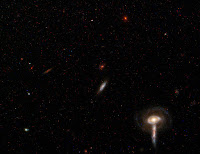This is sharpest image ever taken of the large "grand design" spiral galaxy Messier 81. The image, constructed from a series of images taken with NASA/ESA Hubble Space Telescope, is among the largest ever released. Messier 81 is one of the brightest galaxies that can be seen from the Earth.
 |
| Inner bulge and nucleus of M81 |
 |
| Southern arm of M81 including a chain of HII regions |
The beautiful galaxy Messier 81 is tilted at an oblique angle on to our line of sight, giving a "birds-eye view" of the spiral structure. The galaxy is similar to our Milky Way, but our favourable view provides a better picture of the typical architecture of spiral galaxies. Though the galaxy is 11.6 million light-years away, the vision of the NASA/ESA Hubble Space Telescope is so sharp that it can resolve individual stars, along with open star clusters, globular star clusters, and even glowing regions of fluorescent gas.
 |
| OB Associations in outer northern arm of M81 |
The galaxy's central bulge contains much older, redder stars. It is significantly larger than the Milky Way's bulge. The central black hole is 70 million solar masses, or 15 times the mass of the Milky Way's black hole. Previous Hubble research shows that the size of the central black hole in a galaxy is proportional to the mass of a galaxy's bulge.
 |
| Bulge-disk transition in M81 and chain of HII regions |
 |
| HII shell of M81 and background galaxies |
 |
| Southern extremity of the galaxy M81 |
 |
| Background group of galaxies |
 |
| Wide-field image showing the Ursa Major constellation on lower right |
The Hubble data was taken with the Advanced Camera for Surveys in 2004 through 2006. The colour composite measures 22,620 x 15,200 pixels and was assembled from images taken in blue, visible, and infrared light.
Explanation from: https://www.spacetelescope.org/news/heic0710/





No comments:
Add your comment